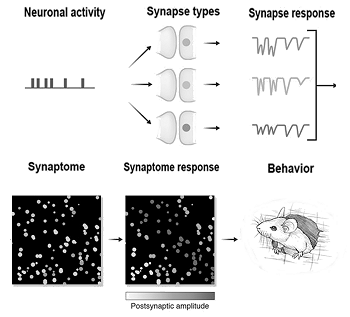 A remarkable paper from a team at Edinburgh explains how every synapse in a mouse brain was mapped recently, a really amazing achievement. The resulting maps are available here.
A remarkable paper from a team at Edinburgh explains how every synapse in a mouse brain was mapped recently, a really amazing achievement. The resulting maps are available here.
We must try not to get too excited; we’ve been reminded recently that mouse brains ain’t human brains; and we must always remember that although we’ve known all about the (outstandingly simple) neural structure of the flatworm Caenorhabditis elegans for years, we still don’t know quite how it produces the flatworm’s behaviour, and cannot make simulations work. We haven’t cracked the brain yet.
In fact, though, the elucidation of the mouse ‘synaptome’ seems to offer some tantalising clues about the way brains work, in a way that suggests this is more like the beginning of something big than the end. A key point is the identification of some 37 different types of synapse. Particular types seem to become active in particular cognitive tasks; different regions have different characteristic mixes of the types of synapse, and it appears that regions usually associated with ‘higher’ cognitive functions, such as the neocortex and the hippocampus, have the most diverse sets of synapse types. Not only that; mapping the different synapse types reveals new boundaries and structures, especially within the neocortex and hippocampus, where the paper says ‘their synaptome maps revealed a plethora of previously unknown zones, boundaries, and gradients’.
What does it all mean? Hard to say as yet, but it surely suggests that knowledge of the pattern of connections between neurons isn’t enough. Indeed, it could well be that our relative ignorance of synaptic diversity and what goes on at that level is one of the main reasons we’re still puzzled by Caenorhabditis. Watch this space.
The number of neurons in the human brain, curiously enough, is more or less the same as the number of stars in a galaxy (this is broad brush stuff). In another part of the forest, Vazza and Felletti have found evidence that the structural similarities between brains and galaxies go much further than that. Quite why this should be so is mysterious, and it might or might not mean something; nobody is suggesting that galaxies are conscious (so far as I know).

Is this the axiom we are faced with…
…the materiality of a galaxy is the same as the materiality of consciousness…
I expect the similarity between the network of galaxies (the galactome?) and the brain’s is due to them both forming due to a kind of self-organizing process, wich will probably naturally yield some kind of scale-free network…
Advanced genomics has proven that the lab animal brain models are invalid for human brains. Human brain development is too different and unstudied. Zebrafish models are even more false – pop science at it’s worst, funded by taxpayers via NIH. Big waste of money and scam.
The mouse synaptome mappings are interesting. Certainly mouse brains are different from human brains, but there are vast commonalities between all animal nervous systems, particularly at the level of neurons and synapses. And the closer on the evolutionary tree we get to humans, the more insight we gain into human brains. So for these purposes, studying primate brains are better than mouse brains, which are better than fish brains, worm nervous systems, etc, but we gain insights from all of them.
The similarities between brains and galaxies is mostly illusory. Human brains have around 86 billion neurons, most of which (69 billion) are clustered in the cerebellum. The cerebrum, the seat of consciousness, only has around 16 billion. The current estimated number of stars in the Milky Way is 400 billion, and the number of galaxies in the observable universe is currently at 2 trillion. Any purported communication between stars would be limited by the speed of light, making significant information processing between them take far longer than the current age of the universe. And the ongoing expansion of the universe will eventually isolate all galactic clusters from each other, cutting off any two way communication long before anything like a universal consciousness could develop. It’s an interesting idea but the physics just don’t support it.